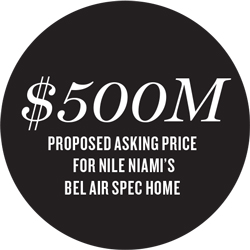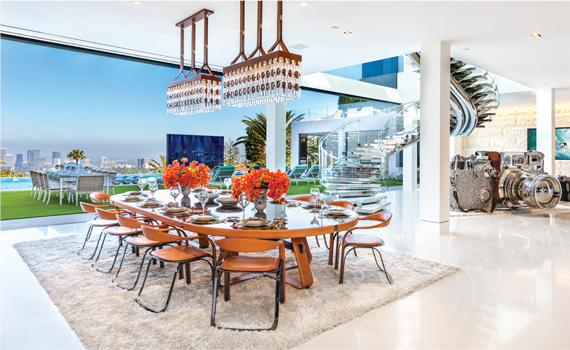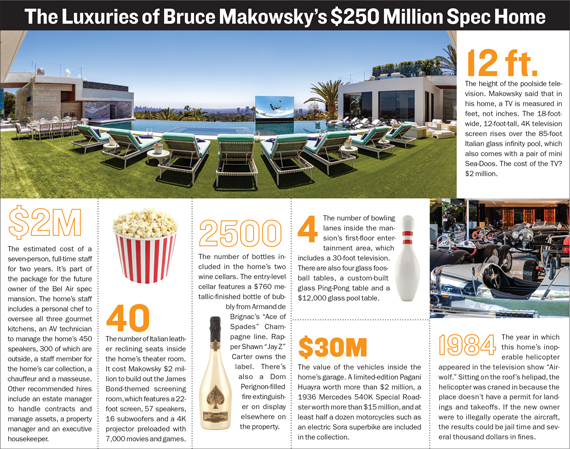Trending
La La Land values: A peek at the numbers behind the spec homes arms race

From the April issue: In February, Douglas Elliman broker Tracy Maltas took a client, a local businessman, to see a property in Bel Air.
Maltas is no stranger to great wealth — she’s the daughter of billionaire former Miramax co-owner Ron Tutor and has seen her fair share of luxury L.A. compounds — but this house took even her breath away.
The $250 million home, the most expensive listing in the nation, was surrounded by a moat-like canal and had its own helipad. The elevator was lined in crocodile skin, Hermès plate settings lined the dining room table, and there was even a Louis Vuitton-designed bowling alley. To top it all off, the home’s developer, Bruce Makowsky, was offering up a $30 million car collection, including a Rolls-Royce, a Bugatti and a vintage Allard, with the property.
Maltas’ client told her he wanted to see the home only out of curiosity — “I would never buy anything that expensive,” he said — but the longer they spent at the listing, the more it seemed her buyer was falling for the home.
“Boys will be boys. They see a toy and it’s like they have to have it,” Maltas told The Real Deal. “We’re halfway through the tour and he’s in all the cars taking pictures. It was a slow build, but by the end I was convinced he was going to buy it.”
Makowsky compared the process to shopping for an engagement ring. “It’s like a woman picking out a diamond,” he said. “It’s an emotional purchase.”
Welcome to the fast-growing world of ultra-luxury spec homes, where some of L.A.’s most deep-pocketed investors shell out tens, or even hundreds, of millions to create extreme residences catering to the global 0.01 percent.
Some call it the riskiest corner of the real estate business, with developers betting their fortunes on the prospect that a Saudi prince, a billionaire tech mogul or a Russian oligarch will fall in love with the home and cut a check for an unprecedented sum. If that buyer doesn’t appear, they could be left fighting off lenders and partners, all while forking out the types of taxes and carrying costs more typically associated with a commercial skyscraper.
 A spate of big-ticket homes that hit the market in recent months has taken the stakes to a new level, leading to speculation that the arms race to build bigger and flashier homes is leading to outsized risk, sources said. That’s especially true in these Trumpian times, as developers worry that the president’s anti-immigrant rhetoric may dissuade some foreign investors from buying here.
A spate of big-ticket homes that hit the market in recent months has taken the stakes to a new level, leading to speculation that the arms race to build bigger and flashier homes is leading to outsized risk, sources said. That’s especially true in these Trumpian times, as developers worry that the president’s anti-immigrant rhetoric may dissuade some foreign investors from buying here.
Some developers have already floundered, namely the prolific spec homebuilder Robert Quigg, who declared bankruptcy late last year. And industry insiders say others may follow.
“People have lost their shirts and are continuing to lose their shirts,” said developer Tariq Jalil, who is trying to sell a Bel Air house, which he built on spec, for $25 million. “L.A. is littered with these people.”
The start line
The arms race began several years ago with just a couple of big sales and, in typical L.A. style, a sprinkling of celebrity intrigue.
Insiders point to the sale of a $32 million home on Oriole Way in the Bird Streets in 2014 as the beginning of the trend. The seller was rapper Dr. Dre (real name Andre Young). The buyer, private equity mogul Alex Soltani, planned to tear down his home to make way for a brand-new $100 million mansion. Around the same time, Oracle CEO Larry Ellison’s daughter, Megan Ellison, snagged a home a 1 Electra Court in the Hollywood Hills for $20 million with a plan to tear it down and start over. Then rapper P. Diddy shelled out $39 million for a Holmby Hills-area mansion that developer Nile Niami had just built.
Industry watchers noticed the increasing demand from both local and foreign buyers for brand-new, state-of-the-art homes in some of the city’s most storied luxury corridors. The residential market was hot, driven in part by a rise in the number of global ultra-high-net-worth individuals looking to put their money in the U.S. The rise of the Chinese buyer was in full swing, with a new billionaire being minted almost every week in China.
“These are land yachts,” Makowsky told TRD. “I never understood why people would pay hundreds of millions for a 300-foot yacht and just $30 million or $40 million for a house. It’s the same level of excitement, but you can live there every day.”
The trend was cemented by a $70 million deal for a Makowsky spec home on North Hillcrest Road in Trousdale Estates, bought by Minecraft founder and serial gamer Markus Persson in December 2014.
For the Swedish gamer, who had just sold his company to Microsoft for $2.5 billion, the house had everything he dreamed of, from a candy room to a garage with a revolving display floor.
“When we were young we did not have a lot of money at all, so I thought, if I ever get rich I’m not going to become one of those boring rich people that doesn’t spend money,” Persson told Forbes.
It was an attitude that Makowsky was happy to capitalize on. “I’m like Tom Hanks in the movie ‘Big,’” the developer said, likening his selection of finishes and amenities to the lead character’s gleeful shopping spree.
Jalil said that deal “set the benchmark.”
“People looked at each other and said, ‘Wait, we can get $70 million for a home in L.A.?’” he said.
Shooting the moon
Today, developers of these spec homes are eyeing numbers a lot bigger than that. Aside from Makowsky’s $250 million mansion, Niami is building two homes of his own, including a $100 million property dubbed Opus on North Hillcrest and a rumored $500 million home at 944 Airole Way in Bel Air.
The prices of these homes are in a league entirely separate from the rest of the L.A. market. On the luxury end of the price spectrum — the top 10 percent of sales — the median sales price for a property was just $6.21 million in the fourth quarter, according to a report by Douglas Elliman. Sales volume of those homes was down by 22.6 percent year-over-year.
The under-construction Airole Way property would be the most expensive ever sold in the world if it trades for even close to its asking price. The compound is slated to comprise a 74,000-square-foot main house, three smaller guesthouses, a 30-car garage and a “Monaco-style casino,” per Niami.
The only threat to the further proliferation of such homes is the increased scrutiny by city authorities of the so-called “mansionization” of certain neighborhoods. In the face of a flood of spec home construction, the L.A. City Council recently approved a measure reducing the size of homes allowed in single-family residential neighborhoods. In some locations, the measure will result in developers being permitted to build to just 45 percent of the lot size, down from 50 percent.
Council member David Ryu has argued that the construction of these mansions leads to “toxic community disputes,” often “pitting neighbor against neighbor.”
Averting disaster
When these projects fail, they fail in the same spectacular fashion in which they were built.
In December, Canadian developer Quigg filed for bankruptcy, leaving behind nine mostly unfinished homes and more than $80 million in debt. The properties are now being sold off by the bank. An unfinished mansion at 1516 Stone Canyon Road is asking $18 million, for instance.

Makowsky’s $250 Bel Air spec home
Quigg’s story serves as a cautionary tale for spec homebuilders, but he’s not the only one to have struggled. Model Gigi Hadid’s father, Mohamed Hadid, was forced to eat the cost of tearing down parts of a 30,000-square-foot mega-mansion he was building at 901 Strada Vecchia in Bel Air after he was caught flouting zoning law by building too big. Angry neighbors dubbed the manse the “Starship Enterprise.”
Because of his alleged overbuilding, Hadid is facing criminal charges, including illegal use of land, building without a permit and failure to obey orders from the L.A. Department of Building and Safety.
Some developers simply got ahead of themselves, Maltas said.
“They may have understood the model when it was an under-$10 million model. But when you get to north of $35 million, there’s a whole other procedure to building it and selling it,” she said.
The inherent risk in building these properties is the enormous upfront cost, sources said. In order to woo a buyer willing to write a $250 million or $500 million check, they need to see the finished product, with all the bells and whistles. That means finishing construction and buying all the extras to make the property sing, including helicopters, cars and art. In the case of the helicopter at Makowsky’s property, it’s illegal to actually fly it, and anyone who did would incur a large fine. But all those accoutrements help a buyer to imagine living there.
“You cannot show a property like this under construction,” said Ari Afshar, a luxury broker at Compass. “People need the picture to be painted for them. If you just show them the canvas, it loses all its appeal.”
Platitudes about the “best of the best” won’t cut it, either. The quality has to be perfect, and value engineering is unacceptable.
“If you’re going to charge $500 million for a house, you better give it an enema,” Maltas said. “The buyer is the kind of person who will have an army of people behind them to prove that it’s not worth what you say.”
Rolling out the dough
When building these types of homes, the idea of budget can become a moving target, which often dissuades traditional lenders from financing the projects. If they do lend, it’s at a price. Jalil said at one point he was forking out $60,000 to $100,000 a month in interest payments on one property. If a home like that doesn’t sell within a year, it’s time to rethink the strategy, he said.
“These lenders are charging an egregious amount,” Afshar said. “You have to pay 10, sometimes 12 percent on these loans, so those that rely on them have a tough time sustaining.”
Makowsky admitted the premise of no fixed budget was somewhat bizarre, but said he’s survived thus far because he’s bankrolling his own deals and refused to take on equity partners or debt.
“I hate Fridays from 3 p.m. to 4 p.m. because that’s when I write my checks,” he quipped. “I take a couple of shots of tequila and I write them.”
Finding a buyer for one of these properties can be like finding a needle in a haystack and requires microtargeting the global wealthy. Some worry that the political climate will get in the way of that mission.
“The statistics bear it out,” Jalil said. “There’s been less tourism and an overall general view that the U.S. is not friendly to foreign nationals. Whether that’s true or not, the perception is there.”
Maltas said she once worked with a developer who specifically targeted registered international owners of yachts 200 feet or more in length. “It could be Hollywood money or Saudi money or New York finance money,” she said. “The only common denominator is that they have a shit-ton of money.”
Spotting that money is a fine art.
“There is a certain type that’s not looking to buy but just wants to impress their girlfriend,” Jalil said. “I can spot them a mile away. They drive up in a Ferrari Testarossa with a beautiful young woman dressed head to toe in Versace. You know immediately that they’re not it.”
Makowsky also uses the car metric to gauge a prospective buyer’s commitment.
“These people don’t drive Porsches,” he scoffed.





